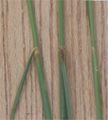| Sheep's fescue | |
|---|---|

| |
| Festuca ovina on left | |
| Scientific classification | |
| Kingdom: | Plantae |
| Clade: | Tracheophytes |
| Clade: | Angiosperms |
| Clade: | Monocots |
| Clade: | Commelinids |
| Order: | Poales |
| Family: | Poaceae |
| Subfamily: | Pooideae |
| Genus: | Festuca |
| Species: | F. ovina |
| Binomial name | |
| Festuca ovina L. | |
| Synonyms | |
List
| |
Festuca ovina, sheep's fescue or sheep fescue, is a species of grass. It is sometimes confused with hard fescue (Festuca trachyphylla).
General description
It is a perennial plant sometimes found in acidic ground, and in mountain pasture, throughout Europe (with the exception of some Mediterranean areas) and eastwards across much of Asia; it has also been introduced to North America.
It is one of the defining species of the British NVC community CG2, i.e. Festuca ovina – Avenula pratensis grassland, one of the alkaline grassland communities. However, the species has a wide ecological tolerance in the UK, occurring on both basic and acid soils, as well as old mining sites and spoil heaps that are contaminated with heavy metals.
Sheep's fescue is a densely tufted perennial grass. Its greyish-green leaves are short and bristle-like. The panicles are both slightly feathery and a bit one-sided. It flowers from May until June, and is wind-pollinated. It has no rhizomes.
Sheep's fescue is a drought-resistant grass, commonly found on poor, well-drained mineral soil. It is sometimes used as a drought-tolerant lawn grass.
The great ability to adapt to poor soils is due to mycorrhizal fungi, which increase the absorption of water and nutrients and also are potential determinants of plant community structure. The symbiosis with fungi increases mineral, nitrogen and phosphate absorption, thanks to fungal hyphae that expand deeply in the soil and cover plant roots, increasing the exchange surface. The symbiosis also makes every plant interconnected with the surrounding plants, making possible the exchange of nutrients between plants far from each other.
More colourful garden varieties with blue-grey foliage are available.
Wildlife value
| This section does not cite any sources. Please help improve this section by adding citations to reliable sources. Unsourced material may be challenged and removed. Find sources: "Festuca ovina" – news · newspapers · books · scholar · JSTOR (June 2024) (Learn how and when to remove this message) |
This is one of the food plants for the caterpillars of several butterflies and moths, including the gatekeeper and the meadow brown, the small heath, and the grass moth Agriphila inquinatella.
Photos
-
 Festuca ovina subsp. hirtula plants
Festuca ovina subsp. hirtula plants
-
 Festuca ovina subsp. hirtula inflorescens
Festuca ovina subsp. hirtula inflorescens
-
 Festuca ovina subsp. hirtula spikelets
Festuca ovina subsp. hirtula spikelets
-
 Festuca ovina subsp. hirtula ligula
Festuca ovina subsp. hirtula ligula
-
 Showing its tufted nature
Showing its tufted nature
Illustrations
References
- "Distribution map for Festuca ovina". Naturhistoriska riksmuseet, Stockholm.
- Wilkinson, M. J. (1991). "A new taxonomic treatment of the Festuca ovina L. aggregate (Poaceae)in the British Isles". Botanical Journal of the Linnean Society. 106 (4): 347–397. doi:10.1111/j.1095-8339.1991.tb02298.x.
- Bradshaw, A. D. (1959). "Population differentiation within plant species in response to soil factors". Nature. 83 (4654): 129–130. Bibcode:1959Natur.183R.129B. doi:10.1038/183129b0. S2CID 4275021.
- Wilkins, D. A. (1960). "The measurement and genetical analysis of lead tolerance in Festuca ovina". Report of the Scottish Plant Breeding Station: 85–98.
- Fuller, Sherry. "Choosing the right drought-tolerant lawn can save water". SWColoradohome.com. Archived from the original on 18 November 2006.
- Marcel G. A. van der Heijden; Thomas Boller; Andres Wiemken & Ian R. Sanders (1998). "Different Arbuscular Mycorrhizal Fungal Species are Potential Determinants of Plant Community Structure". Ecology. 79 (6): 2082–2091. doi:10.1890/0012-9658(1998)079[2082:DAMFSA]2.0.CO;2. ISSN 0012-9658. S2CID 43420426.
| Taxon identifiers | |
|---|---|
| Festuca ovina |
|
This article is a stub. You can help Misplaced Pages by expanding it. |
- Festuca
- Grasses of Asia
- Grasses of Europe
- Grasses of China
- Grasses of Russia
- Flora of Central Asia
- Flora of Eastern Europe
- Flora of Northeast Asia
- Flora of Western Asia
- Plants described in 1753
- Taxa named by Carl Linnaeus
- Fodder
- Garden plants of Asia
- Garden plants of Europe
- Lawn grasses
- Groundcovers
- Ornamental grass

